Water damage can leave a trail of devastation in its wake, wreaking havoc on your belongings and leaving you to deal with the aftermath. When faced with water damage, it’s essential to understand which items are most susceptible to ruin and take steps to protect your valuables from costly losses.
In this article, we will explore the aftermath of water damage and delve into the specific items that are at risk. From electronics to important documents, artwork, and even your flooring, every aspect of your home can be affected. By understanding the potential damage and taking preventive measures, you can minimize the ruin caused by water incidents.
Key Takeaways:
- Water damage can cause significant harm to various items in your home.
- Electronics, such as smartphones and laptops, are particularly vulnerable to water damage.
- Upholstered furniture can suffer severe damage to its fabric and structure.
- Important documents, like legal papers and certificates, are at risk of ruin.
- Artwork and photographs can be permanently damaged if not protected.
- Flooring and carpets are highly susceptible to water damage and require immediate attention.
- By taking preventive measures and acting promptly, you can protect your valuables and minimize losses.
Electronics: The Vulnerable Victims of Water Damage
When it comes to water damage, electronics are among the most vulnerable items in your home. The exposure to water can wreak havoc on delicate circuitry and internal components, rendering your devices useless. Understanding the potential risks and taking immediate action can help minimize damage and possibly salvage your electronics.
Water damage can occur in various scenarios, such as a broken pipe, a flooded basement, or even an accidental spill. Regardless of the cause, the consequences for your electronics can be severe. Water can corrode the metal parts, short-circuit electrical connections, and cause irreparable damage to internal mechanisms.
One of the first signs of water damage to electronics is a malfunctioning device. It may not turn on or exhibit unusual behavior such as freezing, crashing, or overheating. Water damage can also lead to distorted or non-functional screens, loss of data, or reduced performance.
To minimize the impact of water damage on your devices, follow these essential steps:
- Power off: If your electronic device comes into contact with water, immediately power it off and unplug it from any power sources. This will help prevent further damage caused by electrical currents.
- Remove batteries: If possible, remove the batteries from the device to minimize the risk of short-circuiting.
- Dry carefully: Gently dry the exterior of the device using a soft cloth or towel. Avoid using direct heat sources, as excessive heat can cause further damage.
- Air-dry: After drying the exterior, place the device in a dry, well-ventilated area. This will allow any moisture inside the device to evaporate.
- Seek professional help: If your device has been significantly exposed to water, it’s best to consult a professional technician experienced in water damage repair. They can assess the extent of the damage and take appropriate measures to restore your device.
- Backup data: If your device contains important data, back it up regularly to prevent data loss in case of water damage or any other unforeseen incidents.
- Consider insurance: Check if your electronics are covered by insurance that includes water damage. This can provide financial protection and help with the cost of repairs or replacements if necessary.
Remember, the key to minimizing damage to your electronics is acting swiftly. Promptly following the steps above can increase the chances of salvaging your devices and preventing costly losses.
Upholstered Furniture: Drowning in Water Damage
When it comes to water damage, upholstered furniture often bears the brunt of the destruction. The impact on different types of fabrics can be devastating, leaving behind ruined pieces that require immediate attention and action to mitigate further damage.
The first challenge upholstered furniture faces during water damage incidents is the susceptibility of fabrics to absorb water. Whether it’s a couch, chair, or ottoman, water can seep into the fibers, causing them to become waterlogged and increasing the risk of permanent damage.
Immediate action is crucial when dealing with water damage on upholstered furniture. The longer the water lingers, the higher the chances of mold and mildew growth. As the fabric dries, the trapped moisture can create an ideal breeding ground for harmful microorganisms.
To salvage your upholstered furniture after water damage, it is essential to follow these steps:
- Remove the furniture from the affected area and place it in a well-ventilated space.
- Blot excess water using clean towels or absorbent materials. Avoid rubbing or scrubbing, as it can further damage the fabric.
- If the water damage is significant, consider hiring a professional upholstery cleaner who specializes in water damage restoration.
- Allow the furniture to dry thoroughly before attempting any repairs or treatments.
- Monitor the furniture for any signs of mold or mildew growth, and take immediate action if detected.
When dealing with severe water damage or valuable upholstered furniture, it is always recommended to consult with professionals experienced in restoration and recovery. Their expertise and specialized techniques can increase the chances of salvaging your cherished pieces and recovering the ruined fabric.
Remember, time is of the essence when it comes to water damage on upholstered furniture. Prompt action and proper care are crucial to prevent irreversible damage and protect your investment.
Important Documents: Protecting Lifelines
Water damage can pose a significant threat to your important documents, putting cherished records, legal papers, and irreplaceable certificates at risk of being ruined. It is crucial to take proactive steps to safeguard your valuable papers from the devastating consequences of water incidents.
When faced with water damage, time is of the essence. The longer your documents remain wet, the higher the likelihood of irreversible damage. Follow these essential tips to protect and restore your important documents:
- Act quickly: Remove the documents from the water and separate any pages to prevent further saturation. Time is critical in salvaging your papers.
- Handle with care: Avoid excessive handling, as wet paper becomes fragile. Use clean hands or wear non-acidic gloves to minimize the risk of additional damage.
- Air drying: Lay the papers flat on a clean, dry surface, preferably away from direct sunlight. Allow the documents to dry naturally to prevent warping and distortion.
- Document restoration experts: Consider seeking professional assistance from a document restoration specialist who can utilize specialized techniques and equipment to recover and restore water-damaged papers.
Safeguarding your important documents from water damage requires both preventive measures and prompt action. Investing in a fireproof and waterproof safe can provide an extra layer of protection, ensuring the longevity and integrity of your valuable papers.
Remember: Regularly backing up your electronic documents to secure cloud storage or external hard drives can also offer added security and peace of mind.
| Document Type | Protective Measure |
|---|---|
| Legal Documents (e.g., contracts, wills) | Store in a fireproof and waterproof safe or cabinet |
| Certificates (e.g., birth, marriage) | Consider laminating or placing in acid-free sleeves |
| Financial Records (e.g., tax returns, bank statements) | Scan and back up electronically or store in a waterproof folder |
| Family Photos and Heirlooms | Keep in acid-free photo albums or frames, away from areas prone to water damage |
By implementing these preventive measures and promptly addressing water damage incidents, you can protect your important documents and preserve their value for years to come.
Artwork and Photographs: Preserving Precious Memories
When it comes to water incidents, artwork and photographs are particularly vulnerable to damage. These cherished pieces hold sentimental value, capturing precious memories that are irreplaceable. Understanding the potential risks and taking proactive measures can help safeguard your artwork and photographs from the devastating effects of water damage.
Best Practices for Protecting Artwork and Photographs
1. Store in a secure location: To minimize the risk of water damage, consider storing your artwork and photographs in a safe place away from potential sources of water, such as basements and areas prone to leaks.
2. Use archival materials: When framing or storing your artwork and photographs, opt for archival-quality materials. Acid-free mats, UV-protective glass, and acid-free backing boards can help prevent fading, deterioration, and moisture damage.
3. Implement proper handling: Always handle artwork and photographs with clean hands and avoid touching the front surface directly. Wear cotton gloves when necessary to prevent fingerprints and moisture transfer.
Options for Restoration
Accidents happen, and despite our best efforts, artwork and photographs may still encounter water damage. In such cases, it’s crucial to act swiftly and seek professional help for restoration. Professional art conservators and restoration specialists have the expertise to assess and repair water-damaged artwork and photographs, employing specialized techniques to salvage as much as possible.
Restoration options for water-damaged artwork and photographs may include:
- Surface cleaning and stain removal
- Consolidation of loose or flaking paint
- Repairing tears and creases
- Reattaching delaminated layers
- Reframing and returning the piece to its original condition
By entrusting your water-damaged artwork and photographs to professionals, you can increase the chances of preserving the beauty, value, and memories associated with these treasured pieces.
Protecting your artwork and photographs from water damage is essential for ensuring their longevity and the preservation of beloved memories. By following the best practices for protection and seeking professional restoration when necessary, you can safeguard these precious items for generations to come.
Flooring and Carpets: Soaked and Soggy
Water damage can have severe consequences for your flooring and carpets. When exposed to water, different types of flooring materials and carpets can become soaked and soggy, leading to structural damage, discoloration, and even mold growth. It is crucial to identify the signs of water damage early on to prevent further destruction and protect your investment.
Signs of Water Damage on Flooring and Carpets
Water damage can manifest in various ways on different types of flooring and carpets. Here are some common signs to look out for:
- Warped or buckled flooring
- Swollen or cupped floorboards
- Discoloration or stains
- Soft or spongy areas
- Foul odors
- Mold or mildew growth
If you notice any of these signs, it is essential to take immediate action to prevent further damage and mitigate potential health risks associated with mold growth.
Steps to Prevent Further Destruction
To minimize the impact of water damage on your flooring and carpets, follow these steps:
- Remove standing water: Use a wet/dry vacuum or mop to remove any excess water from the affected area.
- Dry the area: Utilize fans, dehumidifiers, and open windows to enhance airflow and expedite drying.
- Disinfect and sanitize: Clean the area with a mixture of water and a mild detergent to eliminate bacteria and prevent mold growth.
- Consult professionals: If the damage is extensive or if mold growth is present, it is advisable to seek the assistance of professional restoration services.
Remember, acting promptly is crucial in mitigating the damage caused by water incidents and preserving the integrity of your flooring and carpets.
Restoration Options for Your Damaged Flooring
In some cases, water damage may necessitate repairs or even replacement of your flooring. The appropriate restoration option will depend on the extent of the damage and the type of flooring material. Here are some common restoration options:
| Types of Flooring | Restoration Options |
|---|---|
| Hardwood | Refinishing, sanding, or replacing damaged sections |
| Laminate | Replacing damaged planks or sections |
| Carpet | Professional deep cleaning or replacement |
| Vinyl | Replacement of damaged sections |
| Ceramic or Porcelain Tile | Professional cleaning and resealing or replacing damaged tiles |
Consulting with flooring professionals will help determine the best course of action for your specific situation, ensuring a proper restoration and minimizing additional costs.
Conclusion
Water damage poses a significant threat to a wide range of items, including electronics, important documents, artwork, and furniture. Understanding the risks associated with water incidents is crucial in order to protect your valuables from costly losses.
By implementing preventive measures, you can minimize the ruin caused by water damage. Safeguarding your electronics, such as phones, laptops, and gaming consoles, with waterproof cases or keeping them out of harm’s way can help prevent irreparable damage and potentially salvage your devices.
Additionally, taking immediate action to protect upholstered furniture, such as sofas and chairs, by removing them from the affected area can mitigate further damage. Similarly, safeguarding important documents like legal papers, certificates, and irreplaceable records in waterproof containers or storing them in elevated areas can protect these lifelines from potential ruin.
When it comes to cherished artwork and photographs, ensuring they are stored in a dry and secure environment can help preserve precious memories. In the event of a water incident, promptly drying and cleaning the affected pieces may provide opportunities for restoration, salvaging what might otherwise be lost.
Lastly, paying attention to the effects of water damage on different types of flooring and carpets is essential. Identifying signs of damage early on and taking steps to prevent further destruction, such as removing excess water and utilizing professional restoration services, can help restore your flooring and minimize losses.
FAQ
What items are most susceptible to ruin after water damage?
Electronics, upholstered furniture, important documents, artwork, photographs, and flooring are some of the items that are particularly vulnerable to damage in water incidents.
How can I protect my electronics from water damage?
To minimize the risk of damage to your devices, keep them away from water sources, use waterproof or protective cases, avoid using electronics near water, and immediately power off any devices that come into contact with water.
What steps can I take to mitigate water damage to upholstered furniture?
If your upholstered furniture gets soaked, remove the excess water, blot the fabric gently, and allow it to air dry. Use fans or dehumidifiers to speed up the drying process and consider hiring professional upholstery cleaners to ensure thorough cleaning and prevent mold growth.
How can I protect important documents from water damage?
Store important documents in waterproof or fireproof containers, make digital copies or backups of essential papers, and keep them in a secure, elevated location. If documents do get wet, gently dry them using fans or dehumidifiers and consult a professional document restoration service if needed.
What can I do to preserve artwork and photographs in the event of water damage?
Remove the affected pieces from the water immediately and gently dab away excess moisture. Do not attempt to separate stuck photos or artwork. If possible, store them in a cool, dry place and contact a professional art restoration service for guidance on further steps to take.
How can I prevent further damage to flooring and carpets after water incidents?
Act quickly to remove excess water, dry the area thoroughly, and use dehumidifiers and fans to speed up the drying process. Consider hiring professional carpet cleaners or restoration specialists to ensure proper drying and prevent mold growth.




















